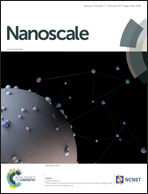Energy transfer and depolarization in the photoluminescence of a plasmonic molecule†
Abstract
We report a comprehensive experimental study of the polarization dependence between excitation and photoluminescence (PL) emission from single dolmen-like metallic nanostructures that exhibit both Fano-like and Lorentz-like plasmon resonances. Though the PL spectra of this plasmonic “molecule” also exhibit the Fano and Lorentz signature, the emitted photons do not maintain the same polarization as the excitation. Surprisingly, the degree of depolarization correlates closely to the resonant excitation of the constituent atoms (single nanorod). More specifically, the excitation of a transverse plasmon mode results in a depolarized emission through the longitudinal plasmon modes of the constituent nanorods. In view of the recent evidence of on-resonant plasmon induced excitations in generating hot electrons, our results suggest that depolarized PL emissions could be enhanced through hot-electron decay. Both macroscopic and microscopic mechanisms are proposed to well-understand the excitation wavelength dependent depolarized photoluminescence behaviors in the plasmonic molecule. Our results lay a foundation for applying the depolarized photoluminescence of complex plasmonic nanostructures in polarization engineering.



 Please wait while we load your content...
Please wait while we load your content...